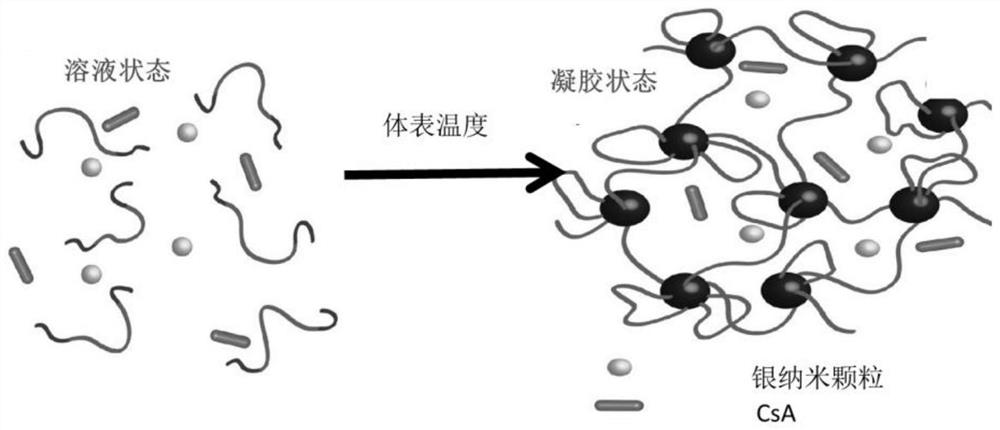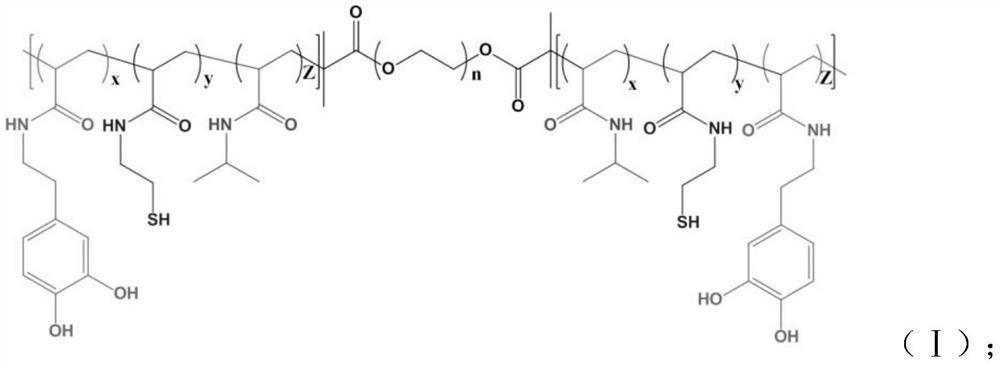Hydrogel material used for treating full-thickness burn wound surface and preparation method of hydrogel material
A hydrogel and wound surface technology, applied in medical science, bandages, etc., can solve problems such as failure to achieve hydrogel, inability to resist bacterial invasion, increase risk of infection, etc., and achieve good postoperative cleaning convenience and good self-healing Performance, the effect of excellent biocompatibility
- Summary
- Abstract
- Description
- Claims
- Application Information
AI Technical Summary
Problems solved by technology
Method used
Image
Examples
Embodiment 1
[0032] A hydrogel material for treating full-thickness burn wounds is an ABA type triblock network copolymer formed by polymerizing polyethylene glycol monomers and N-isopropylacrylamide monomers. The compound comprises a mussel biomimetic tissue bonding group and a silver nanoparticle anchoring group, the hydrogel is loaded with silver nanoparticle, and the surface and interior of the hydrogel are loaded with cyclosporin A. Wherein the ABA type triblock network copolymer structural formula is as follows:
[0033]
[0034] It has temperature-sensitive properties (such as figure 1 ), which is in a liquid state at room temperature or below body temperature, and turns into a gel state at body temperature or when it contacts the body surface, which is convenient for its storage and transportation, and is beneficial for surgical use such as spraying or injection.
[0035] The preparation method of the hydrogel refers to the method in "ACS applied materials&interfaces. 2017; 9(1...
experiment example 1
[0041] Construct rat severe burn model, the hydrogel material obtained in embodiment 1 (with the mass ratio of polyethylene glycol monomer and N-isopropylacrylamide monomer 1:3, the number average molecular weight of polyethylene glycol is 8000 as an example) is used for repairing after burns, and discusses the protective effect of the hydrogel material obtained in Example 1 for the recovery of local tissues of rats after burns and the inhibition of systemic inflammatory response. The method is as follows:
[0042] Take 40 rats and divide them into 4 groups, control group (Control), model group (Burn), positive control group (Burn+Intrasite Gel), and experimental group (Burn+HydrogelA). All rats were shaved on the back, and carried out general anesthesia with 1% pentobarbital sodium 1mL intraperitoneal injection, taking the area as 30% of the total surface area (TBSA=K*W*0.5, K=0.9, W is the weight of the mouse) as burn area. All rats except the control group were anesthetize...
experiment example 2
[0049] The hydrogel prepared in "ACS applied materials&interfaces.2017; 9(11):9221-9225" was used in the severe burn model of rats mentioned above, which was recorded as the positive control group 2. By loading CsA, it was compared with the experimental group of the present invention. The results are shown in Table 2:
[0050] Table 2
[0051]
PUM
 Login to View More
Login to View More Abstract
Description
Claims
Application Information
 Login to View More
Login to View More - R&D
- Intellectual Property
- Life Sciences
- Materials
- Tech Scout
- Unparalleled Data Quality
- Higher Quality Content
- 60% Fewer Hallucinations
Browse by: Latest US Patents, China's latest patents, Technical Efficacy Thesaurus, Application Domain, Technology Topic, Popular Technical Reports.
© 2025 PatSnap. All rights reserved.Legal|Privacy policy|Modern Slavery Act Transparency Statement|Sitemap|About US| Contact US: help@patsnap.com



